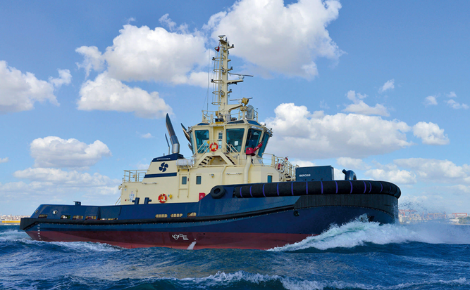The Analysis of Engine Room Vibration of Tugboat 24 M
Main Article Content
Abstract
A tugboat is a ship that guides large ships to dock, helps escort coal barges over bridges and also helps carry out rescues if needed. Some Tugboats had to experience increased engine power because they followed ministerial regulations. When in operation, the tugboat's engine generates the power necessary to move the ship, but on the other hand the engine also produces vibrations. Vibrations that occur on the ship have a side effect that damages the structural resistance of the ship's own construction. The purpose of this study is to find out the value of vibration and noise that occurs on the deck above the engine room due to increased engine power on the Tugboat. The method used is Finite Element Analysis using Ansys software. The results showed that the excitation frequency of the parent machine based on successive rpms was 14.99 Hz, 16.65 Hz, and 18.32 Hz. Based on the calculation of system amplitude, obtained value ranges of 8.73 x 10-10 to 8.25 x 10-10 for 1 machine and 1.14 x 10-9 to 5.65 x 10-10 for 2 machines. Then the standard vibration value is in the range of values 0.00012 to 0.00017 for 1 engine and 0.000652 to 0.000479 for 2 machines. Furthermore, the noise value obtained is in the range of 140.53 dB to 130.88 dB for 1 engine, and 140.68 to 130.75 for 2 engines. All results from calculations regarding vibration standards on the 2 deck models above the engine room get results according to standards, but the resulting noise value exceeds the limit, so it can be concluded that the construction of the engine room and deck is safe from vibration but has excessive noise.
Downloads
Article Details

This work is licensed under a Creative Commons Attribution 4.0 International License.
References
S. Pelindo 4, “Pelabuhan Samarinda,” 2021. https://inaport4.co.id/cabang/samarinda/ (accessed Aug. 23, 2021).
M. Sofi’i and I. K. Djaja, Teknik Konstruksi Kapal Baja. 2008.
M. Y. Ismail, “Analisis getaran dan kebisingan pada kamar mesin dan geladak penumpang kapal cepat aluminium,” Kalimantan Institute of Technology, 2021.
C. H. Gonawan, “Laporan Analisa Modus Getaran Torsional , Logitudinal dan Lateral Serta Tingkat Kebisingan pada Desain Propeller 4-Blade dan Poros Propeller Kapal Laporan Analisa Modus Getaran Torsional , Logitudinal dan Lateral Serta Tingkat Kebisingan pada Desain Prope,” no. May, 2020.
M. Nofia, I. P. Mulyanto, and W. Amiruddin, “Analisa Kekuatan Konstruksi Kapal Tugboat Ari 400 Hp Dengan Metode Elemen Hingga,” vol. 3, no. 1, pp. 118–126, 2015.
Z. Arifin, A. F. Zakki, and M. Iqbal, “Studi Karakteristik Getaran Global Kapal Supply Vessel 70 M Dengan Menggunakan Metode Elemen Hingga,” J. Tek. Perkapalan, vol. 5, no. 1, pp. 137–141, 2017.
Grigoropoulos, G., Adamidis, P., & Nikolopoulos, N. A study on ship engine room vibration and noise. Journal of Low Frequency Noise, Vibration and Active Control, 28(1), 1-14, (2009).
Guedes Soares, C., & Zayed, A. M. The development of a methodology for the prediction of ship engine room vibration. Marine Structures, 13(5-6), 377-404, (2000).
Wang, F., Zhao, Y., & Wang, C. Vibration and noise analysis of ship engine room based on the finite element method. Journal of Marine Science and Technology, 23(4), 734-742, (2018).

